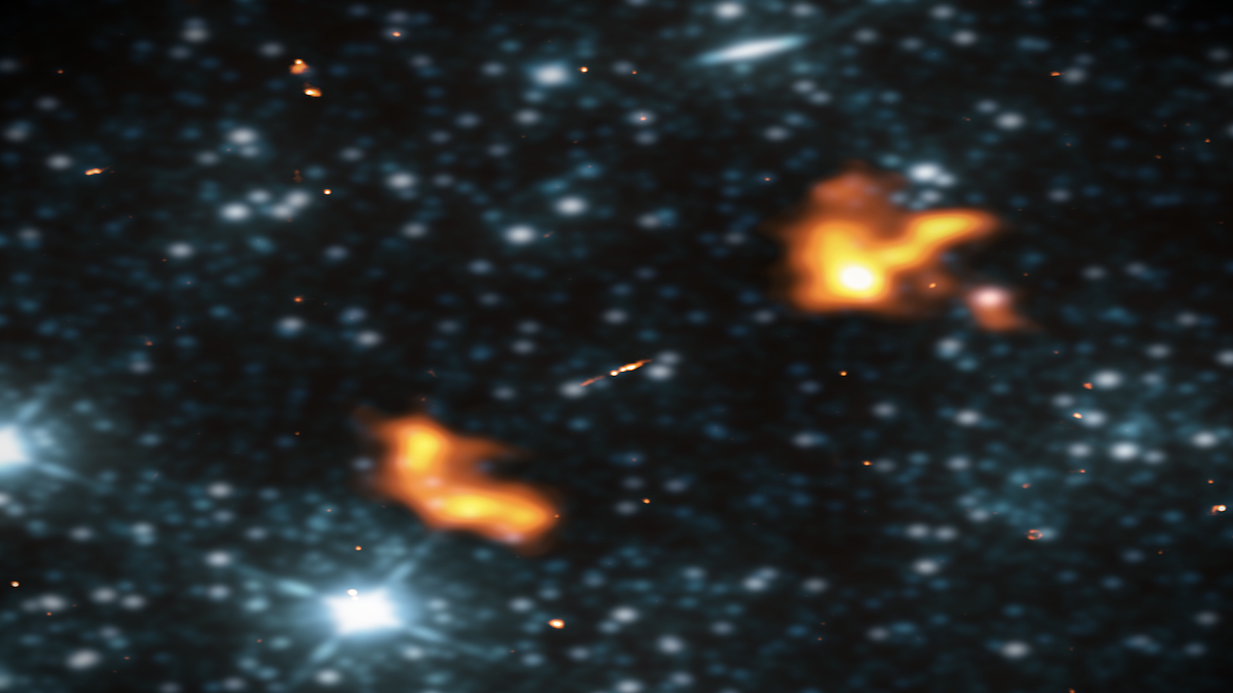Largest galaxy ever discovered baffles scientists
They have no idea how it got so huge.

Astronomers just found the largest galaxy ever discovered, and they have no idea how it got so big.
At 16.3 million light-years wide, the Alcyoneus galaxy has a diameter 160 times wider than the Milky Way and four times that of the previous title holder, IC 1101, which spans 3.9 million light-years, researchers reported in a new study. Named after one of the mythical giants who fought Hercules and whose name means "mighty ass" in Greek, Alcyoneus is roughly 3 billion light-years from Earth.
The galactic monster is an especially large example of a radio galaxy, or a galaxy with a supermassive black hole at the center which gobbles up enormous amounts of matter before spitting it out — sending gigantic two jets of plasma moving at close to the speed of light. After traveling millions of light-years, the plasma beams slow, spreading out into plumes that emit light in the form of radio waves. In the case of Alcyoneus, its lobes are the largest ever discovered.
Related: The 12 strangest objects in the universe
Galaxies that sport gigantic, plasma-filled radio lobes aren't new (even the Milky Way has two small plumes), but how Alcyoneus, a relatively ordinary galaxy at its center, was able to grow such monstrously huge plumes is a mystery to scientists. The researchers released their findings, which have been accepted for publication in the journal Astronomy & Astrophysics, Feb. 11 on the preprint server arXiv.
"We have discovered what is in projection the largest known structure made by a single galaxy – a giant radio galaxy with a projected proper length [of] 4.99 ± 0.04 megaparsecs [16.28 million light-years]. The true proper length is at least … 5.04 ± 0.05 megaparsecs [16.44 million light-years]," the researchers, led by Martijn Oei, an astronomer at Leiden Observatory in the Netherlands, wrote in the study.
The researchers first spotted the new galactic heavyweight after poring through data collected by the Low Frequency Array (LOFAR), a network made by connecting roughly 20,000 radio telescopes distributed across 52 locations in Europe. After processing the data to detect only large and diffuse radio lobes, Oei spotted the enormous structure by accident.
Sign up for the Live Science daily newsletter now
Get the world’s most fascinating discoveries delivered straight to your inbox.
But other than its gigantic plumes, Alcyoneus is a normal elliptical galaxy, with a total mass roughly 240 billion times the mass of the sun (half that of the Milky Way's) and a central supermassive black hole 400 million times the sun's mass (100 times less massive than the largest black hole). In fact, Alcyoneus' center is on the small side compared with those of most radio galaxies.
And it wasn't just Alcyoneus' mass that was oddly run-of-the-mill.
"Beyond geometry, Alcyoneus and its host [galactic center] are suspiciously ordinary: the total low-frequency luminosity density, stellar mass and supermassive black hole mass are all lower than, though similar to, those of the medial giant radio galaxies," the researchers wrote in their study. "Thus, very massive galaxies or central black holes are not necessary to grow large giants, and, if the observed state is representative of the source over its lifetime, neither is high radio power."
For now, the astronomers are stumped, but they are investigating some potential explanations. One possibility is that the galaxy's surrounding environment has a lower density than is usual, enabling its jets to expand across unprecedented scales. Another possible explanation is that Alcyoneus exists inside a filament of the cosmic web, a vast and little-understood structure of gas and dark matter that links galaxies.
The researchers say that finding out what is causing Alcyoneus to balloon in size will be useful for figuring out how other galaxies grow too. "If there exist host galaxy characteristics that are an important cause for giant radio galaxy growth, then the hosts of the largest giant radio galaxies are likely to possess them," the researchers wrote. "Similarly, if there exist particular large-scale environments that are highly conducive to giant radio galaxy growth, then the largest giant radio galaxies are likely to reside in them."
Originally published on Live Science.

Ben Turner is a U.K. based staff writer at Live Science. He covers physics and astronomy, among other topics like tech and climate change. He graduated from University College London with a degree in particle physics before training as a journalist. When he's not writing, Ben enjoys reading literature, playing the guitar and embarrassing himself with chess.









